
table of contents
- Flowering shrubs
- Evergreen
- Deciduous
Flowering hedges form a representative privacy screen with a friendly character. Flowering shrubs are therefore the first choice in order to protect privacy and still give welcome visitors a hospitable insight. Nevertheless, the floral inhibition threshold prevents uninvited guests from brazenly entering the property. If you don't want to wait long for the decorative enclosure, opt for the growth rockets under the ornamental trees. Explore 20 types of fast-growing hedges here all year round.
Flowering shrubs
Evergreen
Evergreen flowering shrubs - year-round privacy protection with no ifs or buts
Flowering shrubs with evergreen leaves and rapid growth are rare in the Central European climate. Most of the frost-resistant ornamental trees shed the leaves in order to be prepared for the rigors of winter. A few survivors have developed strategies to keep their foliage even in severe frost. These premium species among the hedge plants therefore open the list in this selection of fast-growing flowering shrubs.
Firethorn (Pyracantha coccinea 'Red Column')
A firethorn fulfills its task as a flower-rich guardian of your garden in next to no time, because its majestic height is reached within a few years. From May, hosts of white flowers appear above the evergreen, filigree leaves and defensive thorns. In autumn, the fast-growing hybrid 'Red Column' causes a sensation with bright red berries, while the 'Orange Glow' variety trumps with orange-colored fruits. Firethorn is therefore very popular among proud builders to get their new home as quickly as possible to be framed with a decorative hedge, the reliable privacy screen for the whole year guaranteed.
- Height: 200 to 300 cm
- Flowering period: May to June
- Annual growth: 30 to 60 cm

Large-leaved barberry (Berberis julianae)
This barberry is tough, thrives in sunny to partially shaded locations in any good garden soil and cannot be prevented from growing rapidly by severe winters. She persistently wears the evergreen garment of leaves, over which golden-yellow flowers rise in spring. The large-leaved barberry is very popular with gardeners with a preference for reinforced flower hedges. The strong thorns that sprout along the angular branches are up to 4 cm long. Even the leaf margins are covered with small spines. The bluish colored berries that emerge from the flowers are only suitable for decoration and are not intended for consumption. When purchasing, please ask specifically for the botanical name, as the genus of the barberry is also endowed with deciduous species.
- Height: 200 to 300 cm
- Flowering period: May to June
- Annual growth: 30 to 40 cm
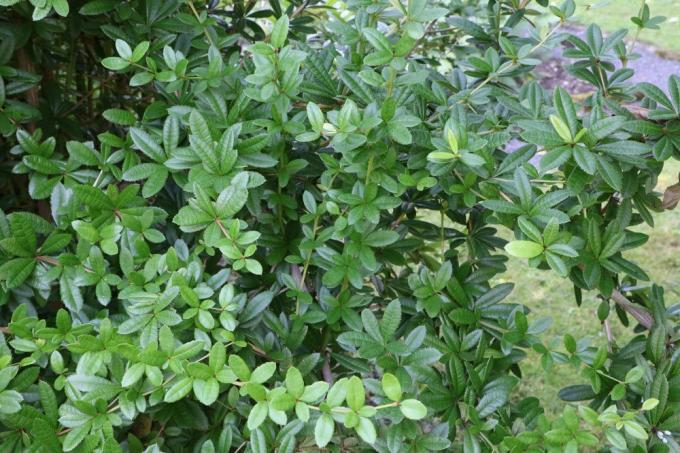
Evergreen Magnolia (Magnolia grandiflora)
The rare Magnolia grandiflora is a pyramidal flower dream for sheltered, winter-mild locations. In contrast to its conspecifics, this type of magnolia thrives as a shrub at a speed that is brisk for evergreen trees. Its huge flowers, which reach a diameter of up to 25 cm on adult specimens, are unique from a distance. In the first five years, winter protection made of leaves on the root disc and in the form of a shading net should guide the beauty of the flowers through the cold season. When the spring-fresh flower magic has faded, the shiny green, rubber tree-like ornamental leaves take over the scepter to preserve your privacy all year round.
- Height: 300 to 800 cm
- Flowering period: April to June
- Annual growth: 20 to 25 cm
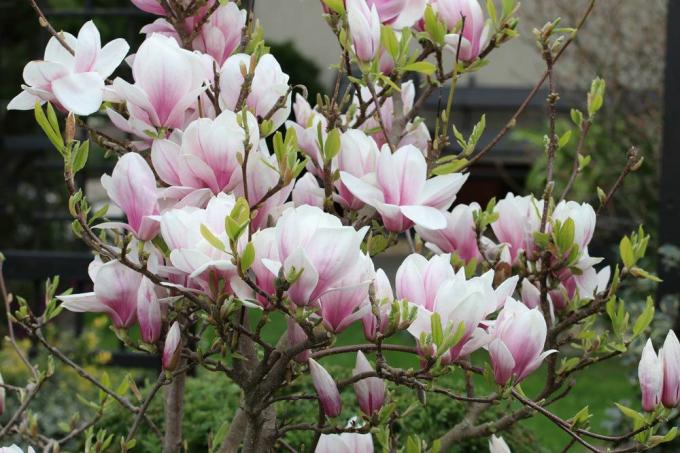
Deciduous
Deciduous flowering shrubs - opaque at the right time
Deciduous hedge species manage their plant energy by foregoing the energy-sapping maintenance of their leaves in winter. The flowering season in spring and summer benefits from this with its lavish blaze of color. The following types of hedges wear dense foliage precisely when family life is relocated to the garden and protection from prying eyes is a priority.
Butterfly bush, Buddleia (Buddleja davidii)
The butterfly bush is one of the most beautiful flowering bushes that form a breathtaking hedge at top speed. The subtropical ornamental wood prefers sunny locations with permeable, humus soil to showcase its up to 30 cm long flower panicles. The combination of bright colors and seductive scent attracts butterflies in flocks, which give your hedge a picturesque appearance. Buddleia owes its robust winter hardiness to its Asian origins. Although the flower shape suggests otherwise, the plant is not related to the common lilac (Syringa vulgaris). Gardeners with a weakness for easy-care hedge plants will appreciate the good-natured cut tolerance of a Buddleja davidii.
- Height: 200 to 300 cm
- Flowering period: July to October
- Annual growth: 50 to 150 cm

Panicle hydrangea (Hydrangea paniculata)
Are you in the mood for a loose, richly branched hedge with a summer sea of flowers and rapid growth? Then we would like to recommend the panicle hydrangea to you. A colorful array of splendid varieties offers a magical spectrum of colors. Innovative novelties even go through a magical color change from white to pink to a spectacular, purple-red finale. The panicle hydrangea fulfills the design dreams of its gardener without much fuss, because in terms of growth speed the flowering shrub is usually ahead of the curve.
- Height: 150 to 250 cm
- Flowering period: July to September
- Annual growth: 30 to 100 cm

Forsythia, golden bell (Forsythia x intermedia)
In mixed hedges, the forsythia should not be missing to usher in the flower festival early in the year. You will not be tortured for long by the picturesque olive tree before it heralds spring for the first time with bright yellow flowers. Within 2 to 3 years, the rapid growth fulfills your desire for a furious flower hedge with a privacy screen effect. A sunny location with nutrient-rich soil has a beneficial effect on vitality and the ability to flower. Since gold bells are only thinned out in spring and are not cut back, the annual growth is not slowed down by the scissors.
- Height: 200 to 300 cm
- Flowering period: March / April to May / June
- Annual growth: 30 to 60 cm
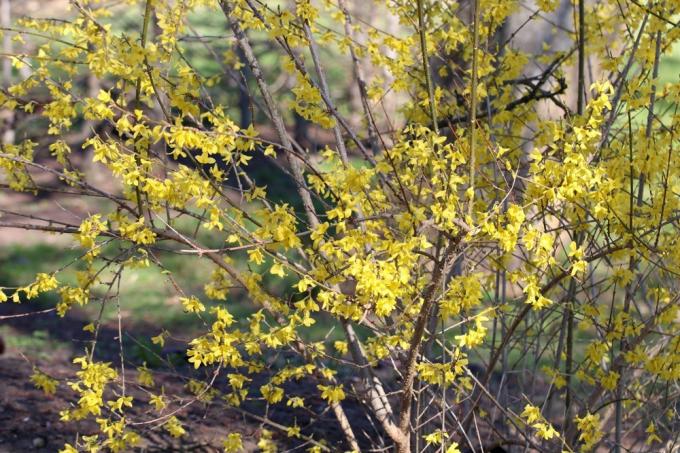
Fingerstrub (Potentilla 'Hachmann’s Giant ‘)
The multifaceted genus of the finger bushes gives us everything a gardener's heart desires, from decorative ground cover to distinctive hedge bushes. If the creative garden design envisages a waist-high flower hedge as a territorial boundary, the 'Hachmann’s Gigant' variety is just the thing. The compact, branched, broadly bushy small shrub frames your garden with a never-ending, yellow flower garment underlined by elliptical, light green leaves. In addition, the ornamental wood scores with uncomplicated maintenance, which is limited to watering when it is dry and a little compost for the nutrient supply.
- Height: 50 to 70 cm (up to 100 cm wide)
- Flowering period: May to October
- Annual growth: 20 to 25 cm (small varieties slower with 10 to 15 cm)
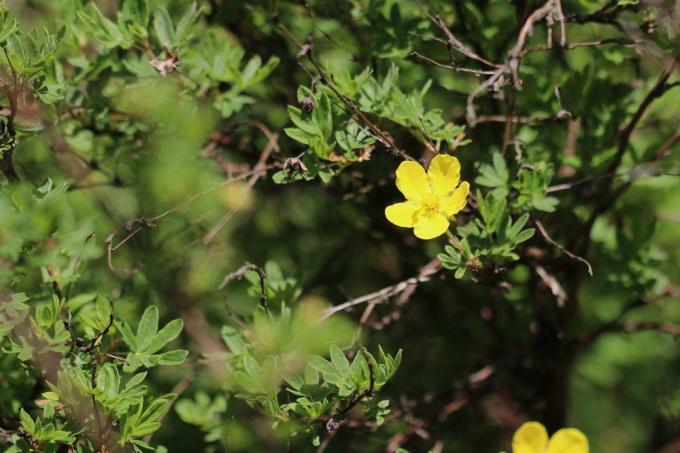
Noble lilac (Syringa vulgaris)
Its lush flowers have inspired poets and composers to write legendary poems and songs for generations. The opulent noble lilac does not only bloom in poetic white. Some of the most beautiful varieties will transform your enclosure into a sea of purple, purple or pink flowers. Coupled with rapid growth and towering stature, Edel-Lilac has earned a place in this selection of flowering hedge plants. However, the large shrub likes to go on a conquest through the garden, where it spreads its strong-growing runners cheekily. By placing young plants in the ground together with a root barrier, you can easily slow down the invasive character trait.
- Height: 250 to 600 cm
- Flowering period: May to June
- Annual growth: 30 to 50 cm

Scented jasmine, farmer's jasmine, pipe bush (Philadelphus coronarius)
Elegance, abundance of flowers and lively growth have made the scented jasmine one of the most popular types of hedges. The tightly upright basic shoots inspire with graceful overhanging side branches. Cup-shaped, mostly lushly double flowers contrast impressively with dark green, pointed-oval leaves. The pipe bush cannot deny that it belongs to the romantic hydrangea family. However, it is much more compatible with pruning and less sensitive to frost than its botanical relatives. In terms of growth speed, it also leaves most of the flowering shrubs behind.
- Height: 180 to 350 cm
- Flowering period: May / June to June / July
- Annual growth: 30 to 50 cm (double-flowering varieties slower with 15 to 25 cm)

Weigelia 'Bristol Ruby' (Weigelia)
Representing the outstanding Weigela species with the potential for flowering hedges, we would like to introduce you to the top-class variety 'Bristol Ruby'. Just in time for the beginning of the most beautiful season of the year, ruby-red flowers shine like sparkling jewels over the bright green leaves. The furious flower show creates an invigorating atmosphere full of positive energy on both sides of the hedge. At the end of the main flowering season, nobody has to be sad, because wherever weigelias feel at home, they surprise with further second blossoms until autumn. In winter, your hedge says goodbye with a spectacular leaf color that blends harmoniously into the landscape.
- Height: 200 to 300 c
- Flowering period: May to July
- Annual growth: 30 to 50 cm
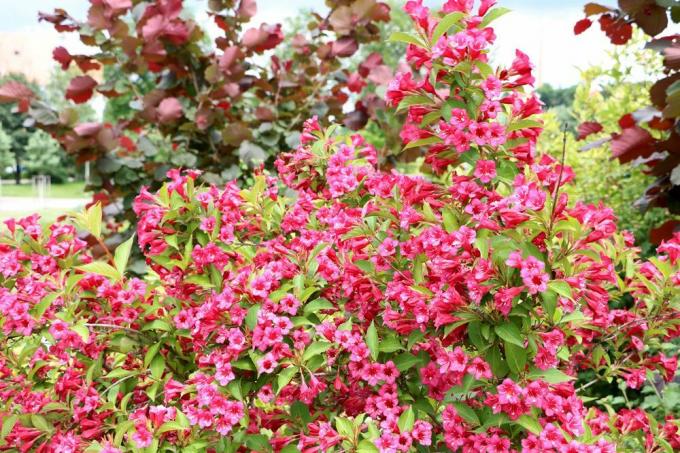
Copper rock pear (Amelanchier lamarckii)
The copper rock pear is a prime example of a fast-growing type of hedge with lavish flowers. The large shrub not only cuts a good figure as a solitary. Together with other ornamental trees, the rose plant forms a stylish hedge that prevents onlookers from seeing through during the summer. The small fruits that ripen in autumn are not only an ornament, but also suitable for consumption. Together with the blazing autumn color of the leaves, the rock pear also inspires with its splendor at the end of the gardening season, before it goes to hibernation.
- Height: 300 to 400 cm
- Flowering time: April
- Annual growth: 30 to 60 cm

Spierstrauch (Spiraea vanhouttei)
The sparrow shrub pulls out all the stops to add floral sheen to your home as a flowering hedge. In spring, the white umbels appear in such large numbers that the dark green leaves are almost completely covered. With this magic of blossoms, the ornamental shrub makes even problematic locations in partial shade shine. The silhouette, which is broadly bushy in youth and tightly upright, develops an elegant appearance with overhanging branches in old age. The list of advantageous attributes is rounded off by a really fast growth rate, reliable winter hardiness and uncomplicated cut tolerance. When purchasing spar shrubs for your new hedge, please make sure that it is Spiraea vanhouttei. In the trade, spar shrubs and the herbaceous perennial astilbe are sometimes both referred to as splendor spar, which can lead to confusion. Therefore, ask specifically for the botanical name.
- Height: 200 to 300 cm
- Flowering period: May to June
- Annual growth: 30 to 50 cm
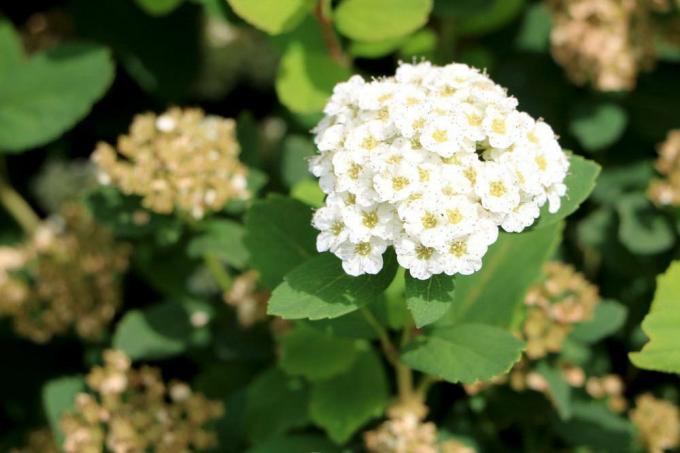
Silver candle bush (Clethra alnifolia)
If you are looking for a fast-growing type of hedge for partially shaded locations, you will find it in the silver candle bush. Its most beautiful varieties shine with large clusters of flowers in extremely delicate colors, without wanting to be permanently spoiled by the sun. The pure species sets itself in scene with white flowers. Subtle pink characterizes the hybrid 'Pink Spire', while 'Rosea' is wrapped in bright pink flowers. The low demand for light makes this type of hedge an ideal candidate for a blooming enclosure of the front garden facing north.
- Height: 200 to 280 cm
- Flowering period: July to September / October
- Annual growth: 15 to 35 cm

Asterisk shrub, Maiblumenstrauch (Deutzia magnifica)
The may flower bush conjures up white, lush panicles of flowers from a myriad of small star flowers for its picturesque spring fairy tale. While with other types of hedges, double flowers are depressing the growth rate, a Deutzia cannot be prevented from lively growth. What is remarkable is the slim silhouette with sparse branching, whose elegant aura no one can escape. This habit makes the asterisk shrub an ideal aspirant for the mixed flower hedge. The distinctive type of hedge enters into a congenial partnership with farmer's jasmine, weigela and buddleia.
- Growth height: 250 to 350 cm
- Flowering period: May and June
- Annual growth: 30 to 50 cm

Purple dogwood, redwood dogwood (Cornus alba sibirica)
With a symphony of colors, a purple dogwood will present itself in your garden all year round. The overture marks the creamy white spring blossom, followed by a furious dark red color in autumn. During the winter, coral-red shoots add colorful accents in the empty garden. The Asian type of hedge does not make you wait long for a representative height. Their aesthetic advantages are paired with rapid growth that can exceed half a meter in any good garden soil in sunny to shady locations.
- Height: 200 to 300 cm
- Flowering period: May and June
- Annual growth: 30 to 60 cm
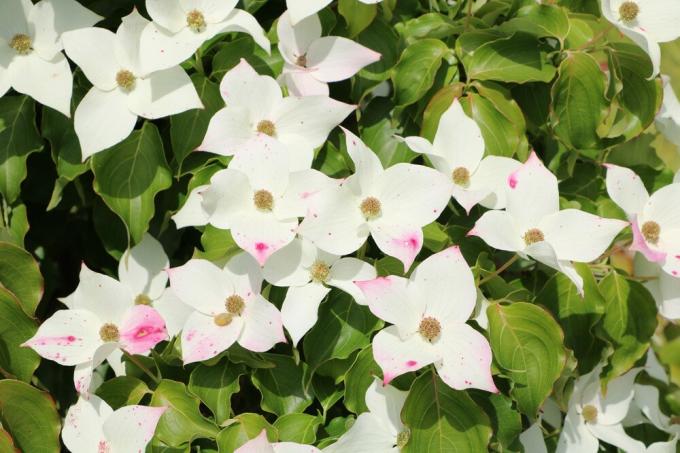
Sloe, hedge thorn (Prunus spinosa)
For the flowering hedge in the natural garden, native wild trees are very popular. The sloe has emerged as a crowd favorite thanks to the abundance of flowers in early spring. Before the leaves sprout in the dense branches, the fruit trees transform your hedge up to the ruff into a sea of white blossoms, from which a subtle almond scent exudes. The first bees, bumblebees and butterflies are very happy because there is sweet nectar to be discovered here early in the year. Your feathered garden dwellers are happy about the black and blue berries in autumn, which the gardener can also nibble on; admittedly only after the first frost. Since the sloe wears a thorn dress, it is very popular with birds as a safe nesting place. As a side effect, Heckendorn keeps uninvited guests at a distance with painful pricks.
- Height: 150 to 400 cm
- Flowering period: March to April
- Annual growth: 20 to 40 cm
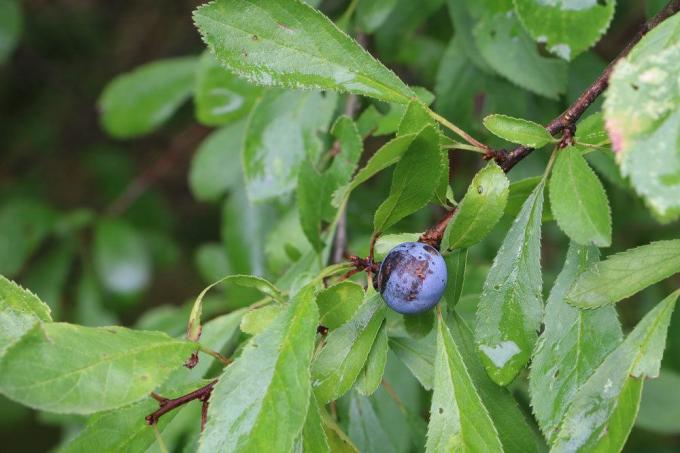
Hawthorn, apple thorn (Crataegus x lavallei)
Hawthorn and sloe form the dream team among the fast-growing types of hedges for the natural garden. When the flowering season of sloes is coming to an end, hawthorn continues the festival seamlessly. Its white flowers, which are decorated with pink stamens, are beautiful to look at. The dark green foliage turns red-yellow in autumn and sticks to the branches well into December. He does not shed the defensive thorns at any time of the year. The orange-red apple fruits, which play an important role in natural medicine, are legendary. The fact that hawthorn thrive as deep-rooted and sloe as shallow-rooted is another argument for combining both types of hedges.
- Growth height: 400 to 700 cm
- Flowering period: May to early June
- Annual growth: 20 to 40 cm

Blood currant (Ribes sanguineum 'King Edward VII')
The blood currant 'King Edward VII' has a red blossom explosion in early spring catapults to one of the top places in the ranking of recommended hedge types with fast Growth. With this hybrid, the focus is less on the berries and more on the distinctive, pink-red flowers that unfold in mild locations as early as the beginning of spring. In contrast to its conspecifics, the berry bush scores with a lively growth, so that it quickly gains height. So much beauty has its price, because the black, blue and white frosted currants are more feast for the eyes than a feast for the palate.
- Height: 150 to 250 cm
- Flowering period: March / April to May
- Annual growth: 20 to 40 cm

Bladder spar (Physocarpus opulifolius)
If you prefer the game of contrasts in garden design, you cannot avoid a bubble spar. Over the course of the year, the type of hedge continues to surprise with new colors. It starts with a dark red leaf shoot in spring in the 'Lady in Red' variety or in a noble golden yellow in the 'Dart’s Gold' variety. While the foliage gradually turns green, the hour for the white flower panicles strikes. In autumn the leaves take over the optical guidance again, because their dark red, later orange-red color is unsurpassed from a distance.
- Growth height: 200 to 250 cm
- Flowering period: June and July
- Annual growth: 30 to 50 cm

Wine rose, Scottish fence rose (Rosa rubiginosa)
The queen of flowers rounds off this selection of flowering hedges in a classy way. At first glance, it may seem surprising that the rose is represented here, as it is usually not characterized by a distinctive growth rate. The wine rose proves the exception to the rule, because as part of the section of native dog roses it leaves boastful hybrid tea roses far behind when it comes to speed. In summer, bowl-shaped, carmine-red flowers with a seductive scent bloom on heavily thorny, densely leafed branches. As scarlet, fragrant rose hips, the flowers complete their floral appearance in autumn.
- Growth height: 250 to 350 cm
- Flowering period: June to July
- Annual growth: 30 to 60 cm




